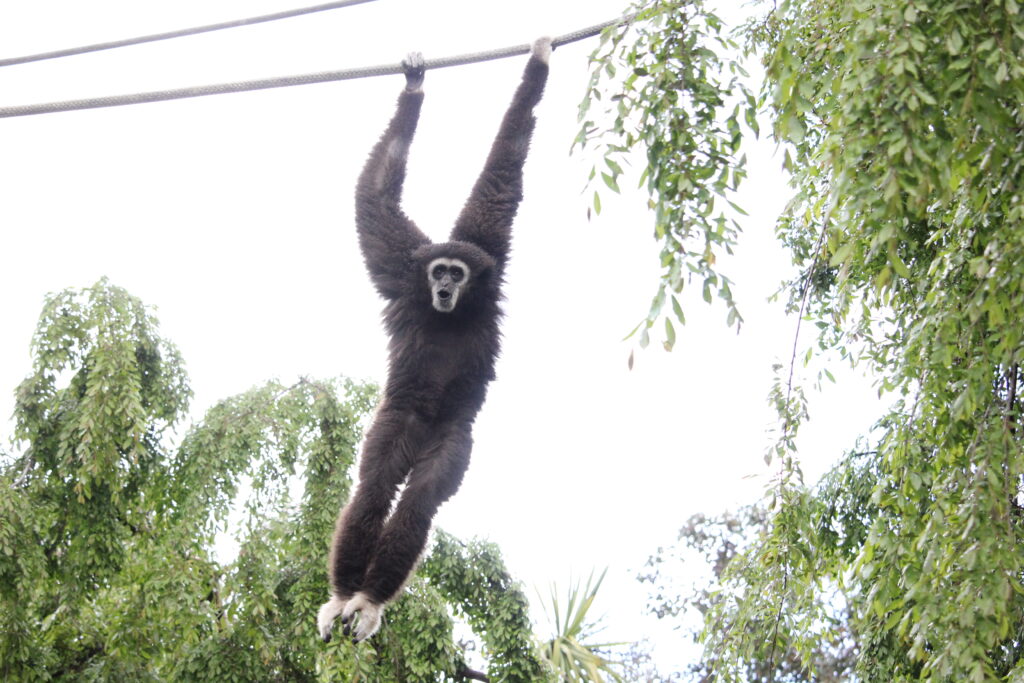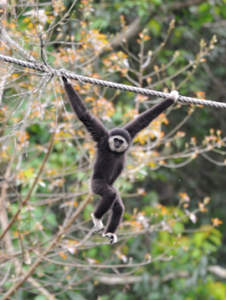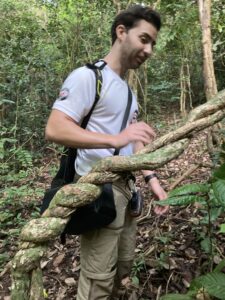Gibbons are arboreal primates critical for maintaining the balance of their forest ecosystem. As seed dispersers, they help to regulate forest regeneration by spreading seeds throughout their habitat, maintaining forest diversity, and supporting other plant and animal species. Gibbons are well adapted to their tree-dwelling lifestyle, moving quickly and gracefully through the forest by swinging from branch to branch using their arms. So, when a gap occurs in the forest canopy, they lose their primary—and safest—mode of transportation.

Like most tropical wildlife, Gibbons are threatened by linear infrastructure development (roads, railways, canals, powerlines, etc.) and forest fragmentation. Twenty gibbon species occur exclusively throughout Asia, and they are some of the most threatened animal groups across the globe; 19 out of 20 species are classified as Endangered or Critically Endangered by the IUCN Red List of Threatened Species.
Peninsular Malaysia is home to three gibbon species: the siamang (Symphalangus syndactylus), the white-handed gibbon (Hylobates lar), and the agile gibbon (Hylobates agilis), all of which are classified as Endangered. Linear infrastructure has been identified as one of the main reasons for the decline in gibbon populations. These structures fragment and isolate forest habitats, making it more difficult for gibbons to move and find suitable territories, mates, and food sources.
With the support of the Center for Large Landscape Conservation, scientists are working to find solutions that conserve connectivity and allow gibbons to move freely across roads. At the 2nd Asia Parks Congress in 2022, staff from the Center met Ben Galea, a PhD student at Universiti Sains Malaysia’s School of Biological Sciences, and first learned of his work. Through a grant from the Center to the Malaysian Primatological Society, Ben is conducting a research project called ‘Canopy bridges to facilitate the safe movement of small apes across habitat fragments in Peninsular Malaysia.’ This research contributes to the effective design, placement, and construction of artificial canopy bridges, which allow animals to safely cross over roads and can help restore connectivity.
Ben’s project focuses on a population of white-handed gibbons (Hylobates lar) in the Beserah Forest Complex of Kuantan, Pahang, Malaysia. This study site is a complex of isolated forest patches surrounded by residential and industrial zones and tourism hotspots. Multi-lane roads separate each forest patch.
To study Gibbon movement, Ben and his colleagues are taking advantage of the primates’ impressive vocalizations. An essential component of the project is piloting the use of passive acoustic monitoring (PAM) and camera traps. They monitor the presence, distribution, and occupancy of gibbon groups in the study area before and after the installation of canopy bridges. This approach not only helps determine the optimal locations for the canopy bridges and map potential core habitat linkages, but also allows them to use individual- or pair-specific acoustic signatures—vocalizations that have unique and consistent patterns—to monitor populations and calling behaviors. (Scroll down to the bottom of this page to hear a gibbon “singing”!)
Through using both sight and sound, they can monitor animal activity before and after they cross the bridges and travel out from the camera traps’ field of view. Over time, the project will experiment with different designs for canopy bridges based on gibbon distribution and behavior. Engineers and arborists will help with final designs to allow white-handed gibbons and other arboreal animals to use the bridges safely. By providing a safe crossing above roads, canopy bridges reduce the impacts of fragmentation and reduce the risk of vehicles hitting gibbons in the rare event that the animals descend to the ground to cross.
As infrastructure development accelerates in Peninsular Malaysia, canopy bridges will become more important in ensuring the long-term survival of arboreal animals. By assessing the behavior and social interactions of gibbons living in areas targeted for re-connection, Ben and his colleagues can monitor the long-term impact of these bridges on animal groups. This information can be used to evaluate the effectiveness of the bridges and document any changes in the behavior or distribution of the animals that benefit from them. Ultimately, this will lead to even more effective use of canopy bridges to reconnect fragmented forests.
Play video clip to hear a white-handed gibbon “singing” in Kuantan, Malaysia!
Video by Melissa Butynski/CLLC






